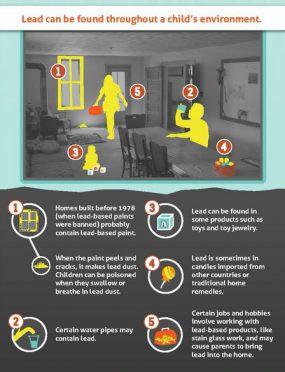Lead is a metal that was once used in different materials both inside and outside of our homes, including paint, plumbing materials, and gasoline. Because there is no safe level of lead exposure, it is important to reduce the chance of exposure as much as possible, especially for infants, young children, and pregnant women. Inside and outside of homes, there are primary sources of lead exposure to be aware of.
Lead Paint
If your home was built before 1978, it most likely has lead paint inside or outside your home, most often this paint is underneath many layers of newer paint. Lead-based paint becomes a hazard when it begins to chip, peel, crack or chalk, or when home renovation projects disrupt the paint. When lead-based paint begins to chip, it often chips or peels in rectangles or squares like an alligator skin and rubs off with a chalky residue.
Most children are exposed to lead when lead-based paint cracks, chips, peels or chalks, especially around windows and doors. This creates dust or small paint chips that can get on a child’s hands or toys. It only takes a very small amount of lead dust to elevate the amount of lead in a child’s blood.
What can you do?
Drinking Water
When lead is found in drinking water, it is usually because the water can dissolve pipes made of lead. While cities are required to treat their water to reduce the risk, when water sits in these pipes for a period of time, lead can get into the drinking water.

Milwaukee’s source of drinking water does not have lead in it.The lead that is found in drinking water is a result of lead service lines and internal plumbing with sources of lead.Milwaukee Water Works treats the water in an attempt to reduce the lead concentrations in drinking water at the tap.Many of Milwaukee's neighborhoods with older homes have a lead service line bringing water to them. To find out, you can look up your home’s address here.
Inside your home, lead may also be present in your plumbing meter and other plumbing fixtures including solder (which joins pipes together). A licensed plumber can help you determine if the plumbing or fixtures inside your home may be made of lead.
What can you do? If you have a lead service line or plumbing:
For more drinking water safety information, visit our Drinking Water Safety page here.
Soil
The most common way for lead to get into soil is from lead paint on the outside of a house. If your home was built before 1978, it most likely has lead-based paint on its exterior. When old paint chips, peels or is scraped off, it falls onto the soil. The area where old paint has fallen is called the drip zone. The lead paint in these areas breaks down into dust where it more toxic and mobile.Soil can also be contaminated along busy roadways from the time when gasoline contained lead, as well as areas where old factories that used lead once stood.
What can you do?
Additional Sources of Lead - Products, Folk Remedies, and Jobs and Hobbies
Lead can also be found in other sources in the home. High levels of lead have been found in products including:
Lead can also be found in some traditional or folk remedies. Some folk remedies contain dangerous levels of lead and other chemicals. These remedies include:
Lead can also be brought into the home if you work with lead or lead-based paint or have a hobby that commonly uses leaded materials. Jobs where lead exposure or the use of leaded materials is common include:
Hobbies where lead exposure or the use of leaded materials is common include:
What can you do?
Additional information can be found:









